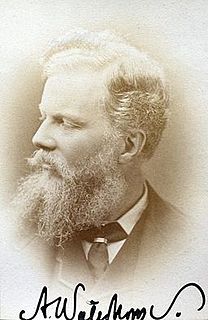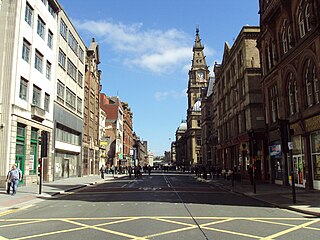
Alfred Waterhouse was an English architect, particularly associated with the Victorian Gothic Revival architecture, although he designed using other architectural styles as well. He is perhaps best known for his designs for Manchester Town Hall and the Natural History Museum in London, although he also built a wide variety of other buildings throughout the country. Besides his most famous public buildings he designed other town halls, the Manchester Assize buildings—bombed in World War II—and the adjacent Strangeways Prison. He also designed several hospitals, the most architecturally interesting being the Royal Infirmary Liverpool and University College Hospital London. He was particularly active in designing buildings for universities, including both Oxford and Cambridge but also what became Liverpool, Manchester and Leeds universities. He designed many country houses, the most important being Eaton Hall in Cheshire, largely demolished in 1961-63. He designed several bank buildings and offices for insurance companies, most notably the Prudential Assurance Company. Although not a major church designer he produced several notable churches and chapels. He was both a member of The Royal Institute of British Architects, of which he served a term as President, and a Royal Academician, acting as Treasurer for the Royal Academy.

Manchester Town Hall is a Victorian, Neo-gothic municipal building in Manchester, England. It is the ceremonial headquarters of Manchester City Council and houses a number of local government departments. The building faces Albert Square to the north and St Peter's Square to the south, with Manchester Cenotaph facing its southern entrance.

King Street is one of the most important thoroughfares of Manchester city centre, England. For much of the 20th century it was the centre of the north-west banking industry but it has become progressively dominated by expensive shops instead of large banks.

Albert Square is a public square in the centre of Manchester, England. It is dominated by its largest building, the Grade I listed Manchester Town Hall, a Victorian Gothic building by Alfred Waterhouse. Other smaller buildings from the same period surround it, many of which are listed.

Tower Buildings is a former office block in the city of Liverpool, Merseyside, England. It stands with its longer front on the east side of the Strand, and extends round the corner into Water Street. The building is located directly opposite the Royal Liver Building, which was designed by the same architect. Earlier buildings on the site have been a sandstone mansion, and a later fortified house known as the Tower of Liverpool. After this was demolished in 1819, it was replaced in 1846 by the first structure to be named Tower Buildings. The present structure is one of the earliest steel-framed buildings in England, and details of its architecture reflect the earlier fortified building on the site. It has been converted into apartments, and into units for commercial and retail use.

The Victoria Building of the University of Liverpool, is on the corner of Brownlow Hill and Ashton Street, Liverpool, Merseyside, England. It is recorded in the National Heritage List for England as a designated Grade II listed building. It was designed by Alfred Waterhouse and completed in 1892. It was the first purpose-built building for what was to become the University of Liverpool, with accommodation for administration, teaching, common rooms and a library. The building was the inspiration for the term "red brick university" which was coined by Professor Edgar Allison Peers. In 2008 it was converted into the Victoria Gallery & Museum.
Paul Waterhouse,, was a British architect.

The Kimpton Clocktower Hotel is a historic hotel structure at the corner of Oxford Street and Whitworth Street in Manchester, England. The building was originally constructed in segments from 1891 to 1932 as the Refuge Assurance Building.

The architecture of Manchester demonstrates a rich variety of architectural styles. The city is a product of the Industrial Revolution and is known as the first modern, industrial city. Manchester is noted for its warehouses, railway viaducts, cotton mills and canals - remnants of its past when the city produced and traded goods. Manchester has minimal Georgian or medieval architecture to speak of and consequently has a vast array of 19th and early 20th-century architecture styles; examples include Palazzo, Neo-Gothic, Venetian Gothic, Edwardian baroque, Art Nouveau, Art Deco and the Neo-Classical.

Gibbs and Canning Limited was an English manufacturer of terracotta and, in particular, architectural terracotta, located in Glascote, Tamworth, and founded in 1847.

Dale Street is a thoroughfare in Liverpool, England, in the Commercial Centre conservation area. The street together with Castle Street, Old Hall Street, Victoria Street and Water Street are the main commercial streets and occupy an area of the medieval town of Liverpool. It contains many Grade II listed buildings.

The architecture of Liverpool is rooted in the city's development into a major port of the British Empire. It encompasses a variety of architectural styles of the past 300 years, while next to nothing remains of its medieval structures which would have dated back as far as the 13th century. Erected 1716–18, Bluecoat Chambers is supposed to be the oldest surviving building in central Liverpool.

1–3 Churchyard Side is a grade-II-listed Victorian Gothic building in Nantwich, Cheshire, England, located on the corner of Churchyard Side and Pepper Street, opposite St Mary's Church. Built in 1864–66 to a design by Alfred Waterhouse as the Nantwich branch of the Manchester and Liverpool District Bank, it is among the most notable examples of Victorian corporate architecture in the town. The building remained a branch of the District Bank until the late 20th century, and is still in use as a bank.
George Tunstal Redmayne, more usually G T Redmayne, was the youngest of four sons of Giles Redmayne and his wife, Margareta Robey. He was born in London and attended Tonbridge School for two years before being educated by private tutors. His father was a wealthy linen draper and silk mercer who owned a house in London and Brathay Hall in the Lake District where he employed architect Alfred Waterhouse in the mid-1850s. George Redmayne became Waterhouse's pupil in 1859 and remained with him as his assistant. He married Waterhouse's sister, Katherine, in 1870 and they had two sons, Martin, in 1871, and Leonard, in 1877. Redmayne died at his residence, Great Stoakley in Haselmere, in 1912.

Holborn Bars, also known as the Prudential Assurance Building is a large red terracotta Victorian building on the north side (138–142) of Holborn in Camden at the boundary of the City of London, England. The block is bounded by Holborn to the south, Brooke Street to the west, Leather Lane to the east and Beauchamp Street to the north. It is currently occupied by De Vere Venues and also the London office of English Heritage at 1 Waterhouse Square.


















